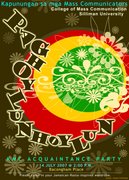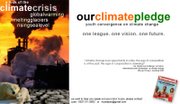
To be honest, I don’t really read komiks or comics!
Wasted is probably the first komik book that I read up to that last page (it was required, anyway). I remember my classmates before in elementary exchanging issues of Archie, X-MEN and a lot more, but I didn’t care much about it. It was probably because of the way komiks are structured (the conversations printed in boxes or balloons, accompanying a scene); I just did not like it. Or maybe I just did not find superheroes that interesting. They were not my type. For the most part, I was just scanning through the pages and admiring the drawings, which I wished I could also do the same.
Wasted is the typical love story of a girl leaving the guy because of another guy. Then, the guy breaks down and does everything to win back the heart of the girl. But, it’s not the typical komiks. No journalist transforming into a superhero. No man being captured by apes and lived in a secluded area in the forest. No masculine figures helping people in the midst or trouble or distress. What is evident are images of man lying on the floor bathed with blood. Bodies exploding from glass windows and bullets coming out from the head accompanied with blood.
Eric, the main character, was a member of a band and was dumped by his girlfriend Jenny, who went with another guy. His life was devastated when jenny left him. Eric expressed his anger in the most extremes way—killing, murder and death. Anger management was not part of his vocabulary.
In the first chapter, he get annoyed with a born again preacher who went knocking on his door, telling him that it was the day that he’ll be saved from all his sins. He also strangled a man to death, who was smoking inside the jeepney. Other casualties include three gays, who verbally harassed him and a corrupt politician, who tried to negotiate with him.
These are not typical scenes in the komiks, which is said to be one of the cheapest means to get a good laugh. The term ‘komiks’ came from the English word comics, which is a 20th century form of art that emerged in the United States. Komiks can be distinguished from other forms of literature because of its: illustrated frames depicting a set of characters, actions read from left to right and balloons accompanying the actions of the characters.
Wasted was illustrated and written by Gerry Alanguilan, who is a licensed architect and graduated form the University of Santo Tomas. This Laguna-based artist ahs come along way after making the decision to pursue komiks over architecture, despite the admonitions of friend and family members. He became a komik book artist after being inspired by Whilce Portacio, who was at that time drawing the “X-MEN’ for Marvel Comics.
He has since them inked various komiks of many artists including Whilce Portacio, Leinil Francis Yu, Gilbert Monsanto and Roy Allan Martines. Among his credits are ‘Stones,’ ‘Wetworks,’ ‘Grifter,’ ‘Wolverine,’ ‘X-Force,’ ‘Fantastic Four,’ and many others. He has also written and drawn ‘Timawa’ for Alamat Comics, ‘Johnny Balbona’ and ‘Lastikman’ for Mango Comics short stories for ‘Siglo: Freedom’ and ‘Siglo: Passion’ and his latest creation ‘Elmer.’
Gerry Alanguilan wrote Wasted during the most turbulent days of his life. During that time, his girlfriend did not fully understood what he was doing and she preferred the architecture stuff than komiks. Eventually, the two of them opt to choose different paths to take and he was left devastated. Also at that time, the late Nail Pozner, an editor, gave him a tests script of Green Lantern to draw. But he mess it up and his work was rejected.
Based on Soledad Reyes’ essay on komiks, I think Gerry Alanguilan did a pretty good job in Wasted, confronting with the aesthetics and functions of the Filipino komiks.
Having read it countless times, still experiencing the feeling of reading it for the first time, it is undeniably entertaining and definitely provides a temporary relief of the unbearable monotony of oppressiveness of life. With the rough and violent images of killing politicians, preachers, deviant citizens and gays due to a mere expression of anger (nothing extra-judicial or potitical), it is definitely a deviance in the monotony of life and finally something was doen to the oppressor.
What Eric did the preacher, the politician, the gays, the man smoking in the jeepney and even to his own body were only manifestations that our emotions have limits. There will come a time when we have to release our deeply suppressed emotions—such as anger, hostility and hatred—without inflicting something to the society. But this time Eric did affect the society.
I think the question of whether it provides a site where the battle of good and evil are played systematically with the forces of light eventually gaining victory over the dark forces is irrelevant in this certain story. What is significant in this story is not what is evil or what is good, but Eric has become and what has made him become that way. If he is the evil persona, what is no significant is him going to jail for killing to jail for killing those people, but what is he willing to risk in order to win back the heart of the one he loves.
Does it foster national language? Practically, it does not because of the use of a foreign language, which is English. However, there is something very Filipino to the story. It could be in the plot or the tone of the writer. It could also be in the images that Gerry Alanguilan has created or the characters like the preacher, the gays, the politician or any of them.
Until now there is still an unending debate on how to interpret literature. Whether to look at it at a piece of art and interpret it for art’s sake alone, or to put it into context and look at the social implications and relevance. But, do we have to make a choice between the two?
For this part, I will start with the latter. In reading the story, I noticed something very ‘feminist’ in the plot. This time it is the girl who leaves the guy and went with another guy. It is justified enough to say that what happened to the male persona was caused entirely by the female persona. In this story, it is no longer the female that is subordinate to the male specie. Although, I can’t see indications that in that particular society there is an established equality between both genders.
Eric was devastated when Jenny left him. He resorted to different forms of violence just to express his anger, fury and rage. All that he was asking for was Jenny to come back to his life.
In interpreting the story as art in itself, it is irrelevant to ask the question on whether Eric’s persona is good or evil. Gerry Alanguilan made Eric that way because that was how he wanted Eric to be. Eric does not represent any oppressive figure in the society or any person that Alanguilan wants to popularize.
As a whole, everything in the story including the graphics has to be there not because have special roles, but because they are part of the story that is a sheer creation of the artist’s mind. Wasted does not advocate any theory or perspective. It is a form of art based on the taste of it creator.
What I like most about wasted is the “humanness” of the story. Anger is defined as a strong feeling of displeasure of antagonism. Anger is something that is very human and an inevitable condition of the human life. People experience anger in the most complicated or most mundane situations in life.
Ever experienced encoding your ten-page term paper that is due the next day and before you finished the last page there’s a sudden power interruption, and the saddest part is that you forgot to save what you have encoded? In just a second, everything is gone. Then, you suddenly felt an upsurge of emotion and you would want to immediately crush the monitor in front of you. Now, that is anger!
Anger confronts us everyday in our lives and we have different way to cope up with it. In Eric’s case, he has a very extreme way in dealing with anger, which I actually like. If you happen to come across Eric’s way and unfortunately you annoyed him and he finds you very irritating, he just points a gun on you and in just a second—you’re gone.
The urge to kill is basically part of the human instincts. (Although, there is a moral or ethical question attached to it.) There are just certain situations in life that we want some people to just vanish instantly from this planet. I think humans resort to killing because it is probably the fastest way to get rid of the problem. That person might be the direct cause of your miseries or otherwise: He or she could be one of your political adversaries. Or she could be your nagging landlady. Or that person who sits right next to you in a restaurant and annoys you every time he or she tries to eavesdrop at you conversation with your date.
There are just certain situations in the story that you would find yourself in the character of Eric and eventually thanking him for responding in such a way that you would want to, but just could not do. There is a certain Eric in each one of us, and that I find very interesting.
Another very interesting theme in the story is what Eric has become because of love. Love is aid to be the most complicated emotion (if it such) humans could experience and it is beyond human comprehension. In Eric and every person’s case, love could either bring out the best or worst in them.
Eric loved Jenny so much. He was happy and contented with her. Jenny loved him too, but she found another guy who could make her happy aside from Eric. Eventually, Jenny broke up with him. Eric’s life was a mess when Jenny left him.
This is a painful fact of life. We fall in love so desperately to persons who will love us, but eventually fall out of love for us. We have no choice but move on, but moving on takes so much time and courage. It takes so much courage to finally say to yourself that you are no longer meant for that person.
For Eric, love made him appreciate the simple details of life. Love made him experience the best and worst things in life. Love made him do things that he never thought he could do. Love made his smile despite of the unpleasant things that are happening around him love made him want to share every beautiful thing in this planet with Jenny. Love made him human.
Wasted is the type of graphic novel that is best to read at 1 o’clock in the morning, when you have tons of things to do and sleeping is never an option. The images in this book—blood spilling out from bodies, perfectly detailed gunshots, bodies falling from buildings, bodies lying in the floor bathed with blood, bodies exploding form glass windows—will definitely awaken your senses. At the end of the story, the reader would not hate Eric despite of it.
Violence, in this case, is very entertaining. But remember—for mature readers only.





















